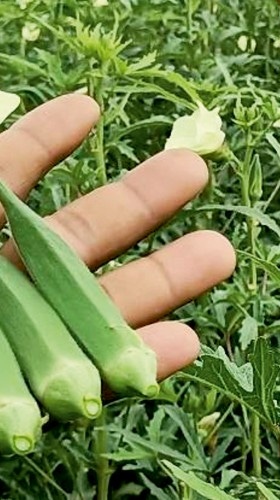Okra Disease Management
Bhendi Yellow Vein Mosaic Virus (BYVMV)
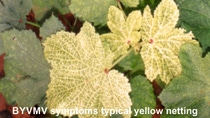
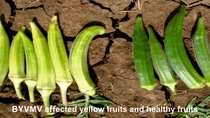
Causal Agent:
Bhendi Yellow Vein Mosaic Virus (BYVMV) - transmitted by whiteflies
Distribution:
All the states in India and Many countries.
Symptoms:
Symptoms include vein clearing and vein chlorosis of leaves. The complex network of interwoven yellow, thickened veins and veinlets encloses islands of green tissue. In severe cases, the chlorosis may extend to the interveinal area and leaves may turn completely yellow. Fruits are dwarfed, malformed and yellow-green. It might cause 80% yield loss and is almost endemic.
Transmitted by white fly Bemisia tabaci. It causes huge loss if disease occur at early stage of crop. The whitefly vector reproduces quickly to reach significant numbers during the summer season and it transmits the virus between okra plants.
Conditions for Disease Development:
Environmental conditions are very important, BYVMV incidence and whitefly population increase with high temperature with moderate humidity. The optimum temperature is 28-30oC for whitefly to buildup and rapid replication.
Control:
The cause of this disease is a virus for which there is no cure.
The only effective control measure is prevention. The following measures for prevention could be taken to minimize yield loss:
- Use of resistance varieties
- The field should always be free from weeds
- Roughing of infected plants and burned
- Whitefly management by spraying insecticides at 10-15 days intervals, starting 20 days after sowing
Okra Enation Leaf Curl Virus (OELCuV)
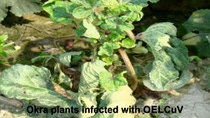
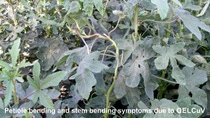
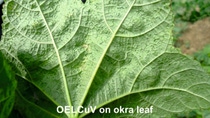
Causal Agent:
Okra Enation Leaf Curl Virus (OELCuV) - transmitted by whiteflies
Distribution:
Many states in India.
Symptoms:
The initial characteristics symptoms of OELCuV are on lower surface of leaves we will see a small pin head enation. Typical petiole and stem twisting with symptoms of vein thickening. Leaf curling and enations on the veins on the abaxial side of leaves. In severely infected plants all the leaves are curled, further growth is retarded and looks bushy and fruit-bearing capacity is drastically reduced.
Transmitted by white fly Bemisia tabaci. It causes huge loss if disease occur at early stage of crop. The whitefly vector reproduces quickly to reach significant numbers during the summer season, and it transmit s the virus between okra plants.
Conditions for Disease Development:
Environmental conditions are very important, BYVMV incidence and whitefly population increase with high temperature with moderate humidity. The optimum temperature is 28-32oC for whitefly to buildup and rapid replication.
Control:
The cause of this disease is a virus for which there is no cure.
The only effective control measure is prevention. The following measures for prevention could be taken to minimize yield loss:
- Use of resistance varieties
- The field should always be free from weeds
- Roughing of infected plants and burned
- Whitefly management by spraying insecticides at 10-15 days intervals, starting 20 days after sowing
Jassids
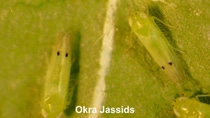
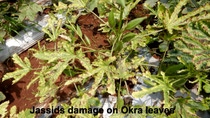
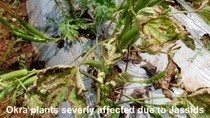
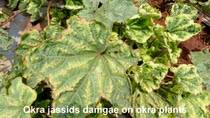
Symptoms of damage:
Damages resembles the response of plants to drought stress or nutrient deficiencies. Leaf hoppers feed on the undersurface of the leaves. Injury usually starts with chlorotic areas developing around the feeding points and alight rolling of the leaf’s edges. Generally, the symptoms are known as “hopperburn”, later the chlorotic area expands to the rest of the leaf blades. Leaves may curl downwards and seen reddening of leaf lamina from margin and finally fall off. This leads to stunted growth and may reduce the fruit yield.
Identification of pest:
Adults are greenish yellow wedge shaped with a pair of black spots on the vertex and black spot on each of forewing. Nymphs are greenish and translucent, wingless found between the veins of leaves on the under surface. Both adults and nymphs walk diagonally.
Management:
Spray any one of the following insecticides.
Afidopyropen 0.5ml/liters, Flupyradifurone 2.5ml /liters Flonicamid 0.3ml/liters, Imidacloprid 0.25-0.5ml/ liter of water or Fipronil 1-1.5 ml /liter of water or Thiamethoxam 0.25-0.5 gm/ liter of water or Acetamiprid) 0.75gm/ liter of water, NSKE 5%.
